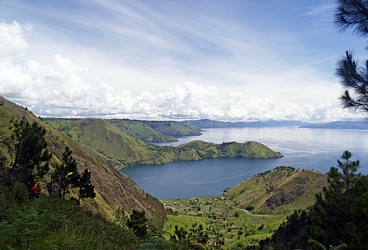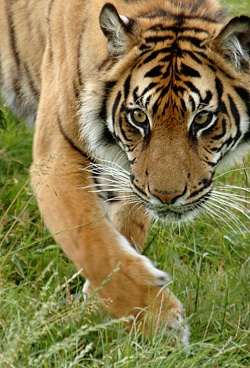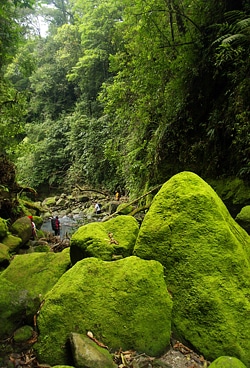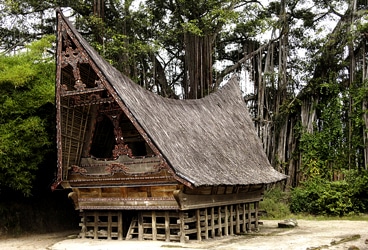Classic Article: Sumatra Indonesia Best Trip
"I only got a brief glimpse," Debs said, referring to the orang pendek, a humanoid creature best described as the Sumatran Sasquatch. "Three or four seconds at most. But I thought I'd hit the jackpot — that I was going to get my picture on the cover of Time." You never know what to expect after 20 years, whether a person you knew will be the same, whether you'll even recognize her. But Debbie Martyr had passed through the decades and through her lengthy adventure in Sumatra's jungle essentially unchanged. Here was the same Debs I had shared a house with in London in the late '80s — eccentric, resourceful and refreshingly unjaded. She met us in front of her house, a wooden bungalow on the outskirts of a town called Sungai Penuh, a drowsy little hive of humanity in the middle of Kerinci-Seblat National Park, Sumatra's largest nature reserve, located in a long earthquake-carved basin surrounded by a crown of seven volcanoes.
We arrived looking like the thousand miles of bad road we'd just crossed, but within minutes photographer Ian Lloyd and I had our feet up and cold Bintang beers in hand. Rain lashed the bungalow's metal roof as our host told us how she'd ended up so far from the English countryside of her childhood and why she'd stayed for decades. Bleached white tapir skulls perched on the bookshelf behind my chair. A plastic bag of animal bones sat on the desk next to Debbie's laptop.
She had first heard about the orang pendek (Bahasa for "little man") while climbing the Mount Kerinci volcano in 1989 and had come back a few months later with an assignment to write about the mythical beast. But then she saw the thing with her own eyes — a hairy bipedal animal about three and a half feet tall with broad shoulders and powerful arms. That ephemeral encounter was enough to convince Debbie that the orang pendek was more than legend. Scores of people have reported spotting it over the past 200 years, and Debbie has seen it several more times. She and British wildlife photographer Jeremy Holden have collected the creature's scat and clumps of its hair, and they've found nests. Until they get a photograph, capture a live specimen or find remains, however, there's no proving what the creature really is.
"You know," Debbie mused as the evening wore on, "the orang pendek got me to Sumatra, but it's not why I stayed."
"So why did you stay?" I asked, falling into her trap.
"Tigers," she said.
Ian and I had met up in Singapore, and we flew into the city of Medan in northeastern Sumatra, where Ade Badan, a local translator and guide, waited. He had secured a vehicle for our journey across the vast island. On the way out of town we ducked into one of the roadside stalls that sell mobile phones and purchased a SIM card. Soon we had Debbie on the line. Her voice was faint, given that she was talking to us on a satellite link from the middle of nowhere, but it was essentially the same earthy timbre I remembered from our London days. "Do you realize how far you have to drive?" she crooned in her English accent.
Actually, I didn't. Looking at a map of Sumatra and tracing out a tentative route is one thing; driving those roads is quite another. Landslides, fallen trees and construction frequently make portions of the narrow, meandering Trans-Sumatran Highway impassable. Crossing the island between Medan and Debbie's digs would take four solid days of driving.
As we left town, a small tremor shook Medan. Ade laughed it off. "We have earthquakes every day," he joked. "They're like entertainment now for Sumatran people. They're like chili — we cannot live without them." The highway soared into the Batak highlands, home to the first of several indigenous tribes we encountered on our journey. Isolated in their mountain homes, the Batak were never converted to Islam and remained avidly animist until the arrival of German missionaries in the mid-19th century. Even then, they clung to ancient ways, including human sacrifice and cannibalism, which didn't peter out until right before World War I.

Punctuating the highlands is Danau Toba, a massive crater lake born of a volcanic eruption about 75,000 years ago, so enormous it may have triggered an ice age. The explosion also separated Sumatra into two distinct flora and fauna zones: North of Toba there are orangutans but no tigers; south of Toba is the opposite — tigers but no great apes. Unless you count the orang pendek.
A one-hour ferry took us to Samosir Island in the middle of the lake, a longtime stop on the hippie trail across Asia, allegedly because of its magic mushrooms. (An older, long-haired American on the ferry confessed he was a "secret agent" on a mission for the U.S. government.) The island feels like a miniature Bali, the lakeshore strewn with tourist lodges, funky cafes and open-air workshops where Batak artisans make textiles and wooden sculptures.
Samosir is also the heartland of Batak culture, as personified by the megalithic monuments of Ambarita, among them an outdoor law court with 300-year-old stone tables. The rajah and elders settled tribal disputes and meted out justice from this site, the prisoners confi ned to a bamboo cage while awaiting their fate. "The most serious criminals — those who murdered or raped or who were caught sleeping with the rajah's wife — were executed and eaten," Ade told me. It was apparently a long and torturous process, during which lime juice was squeezed into the victim's wounds. "The people believed back then that the more you screamed, the faster the evil spirit would leave your body."
Nowadays Toba couldn't be mellower. Ian and I lingered for two days, walking through the rice paddies in the rain, riding rented motorbikes into the rice terraces and pine forests that dominate the island's interior, and simply staring at the big, puffy clouds that formed over the lake each afternoon. It may have been the prospect of tripping out that lured hippie backpackers to Toba, but it was the big sky and endless water that kept them here for weeks, months and sometimes years. It wasn't easy to tear ourselves away.
South from Toba, the Trans-Sumatran Highway cuts a diagonal swath across the middle of the island for nearly a thousand miles. Although the rugged volcanic backdrop remains the same, the cultural landmarks gradually change: The small Christian churches that populate the Batak countryside give way to the golden- or green-domed mosques that dominate the Muslim villages of the Mandailing region.
Debbie certainly isn't the only outsider doing strange and wondrous things in Sumatra. Albert Taylor, a gregarious Australian, gave up a career as a surfboat captain to pursue the not-too-glamorous life of a modern-day coffee baron.
At his estate in the mountains north of Bukittinggi, Albert explained his transition. "I was living down in Padang with my wife, who's Sumatran, and one day her father came down from the hills with a bag of the most amazing coffee I had ever tasted. We spent years trying to fi nd the original Mandailing bushes — the ones the Dutch had planted so long ago."
For anyone who knows coffee, Mandailing is a special name. Nearly 200 years ago, the Dutch came to these highlands seeking the perfect altitude, soil, temperature and moisture for growing coffee. Mandailing was allegedly the first high-quality Arabica exported from Indonesia. The coffee plantations were largely abandoned during World War II.
On his search for the old plants, Albert kept coming across tan clumps of coffee beans stuck together like peanut brittle on the forest fl oor. Locals later explained the clumps were the dung of nocturnal civet cats (or luwaks) that had eaten the fleshy coffee pulp and then excreted the beans. And this luwak scat made a pretty darn fi ne cup of coffee once thoroughly cleaned and roasted.
Albert now exports both his regular Arabica and the exotic kopi luwak. The latter sells for $50 a cup in the swank coffee shops of New York and Sydney. "This hill is full of raging, caffeine-addicted cats," said Albert, half joking. "Their scat comes out almost pure coffee. The moon cycle affects what they eat, and that affects the taste of the coffee. There's one part of the lunar month when they eat more fruit, which gives the coffee a fruity flavor."
Late at night in the clapboard house that serves as estate office and sleeping quarters, the conversation turned to the other wildlife that Albert shares his mountain with. "We're due for some rogue tiger to wander through. It happens all the time in Sumatra," he said. He whipped out an e-mail from "some tiger lady" down south. It related how a big cat had killed three people in recent weeks. The gruesome dispatch was simply signed "Debs."

Tigers. The first morning after our arrival, Debbie piled us into her Ranger pickup to visit the national park mess hall, where we'd meet the people she worked with. The wet weather continued, but a little rain wouldn't keep Debbie from her daily rounds.
She drove us into the jungle along an ever-narrower road flanked by razor-sharp elephant grass trees hung with wild orchids. Crossing over to the other side of the mountains, we were confronted by a wall of rainforest. Virtually untouched and uninhabited, this side of Kerinci, larger than Yellowstone and Yosemite combined, is the essence of what the park is all about.
"When I was researching the orang pendek," Debbie explained as we went, "I came across this tiger thing — the fact that Sumatran tigers were quickly disappearing from the wild. I kept sending messages to environmental groups back in Europe but didn't get much response. By default I ended up doing it myself. It was the only way to get it done."
She did persuade one environmental group, Britain's Fauna & Flora International, to fund her work. Over the years, that bootstrap save-the-tiger effort has evolved into a 24-person conservation unit that works on various projects: the elephant-human conflict on the park's southern fringe; encroachment by coffee plantations; illicit marijuana cultivation; and incidents with individual animals, including the orphaned sun bear Debbie had moved out of her house a few days before our arrival.
But her primary concern is saving the Sumatran tiger from extinction in the wild. Dutch colonial authorities estimated that around 10,000 roamed the island at the turn of the 20th century. By the time Debbie arrived 15 years ago, that number had dropped to 400. Thanks to the conservation unit, the tiger population inside the park has started to rise since 2005.
"We've pretty much shut down the trade in tiger skins because poachers find them nearly impossible to sell," says Nandang Gumilar, the tiger unit's field operations manager. "But there is still the problem of tiger parts used in traditional Chinese medicine and villagers killing tigers when they feel their livestock or families are being threatened."
Kerinci lies on the fringe of the Minang highlands, homeland of the Minangkabau tribe, renowned for their traditional adat houses featuring richly painted facades and soaring gabled roofs. A deep matrilineal tradition also sets them apart. Being married to a Minangkabau woman, our guide Ade Badan was well-versed in local customs. "Children take the name of their mother's clan, not their father's," he told me. "Property is also passed down through daughters only. The sons get nothing. When a man divorces his wife, he must leave the house with only the clothes on his back!"
Women also control the purse strings, an unmistakable fact during our sojourn in the highland town of Bukittinggi. All the stores appeared to be run by females. Anita Syofyan, who owns a cyber cafe on the main street, told me, "Minangkabau women have a mind for business." Then she launched into a passionate homily on why Hillary Clinton should be the next U.S. president.
This long matrilineal heritage had provided a framework for Debbie's existence, allowing an infidel female to thrive in a Muslim society. Debbie might have been doing something radical for a convent-schooled lass from Gloucestershire, but in Sumatran terms it was par for the course. The local people understood strong women, and the fact that she was foreign and Christian didn't seem to matter much.
A mother tiger with two cubs had been wandering the edge of the rice fields on the southern side of the Kerinci valley. A young female tiger had been caught accidentally — and strangled to death — in a farmer's pig trap. And a rogue male tiger had killed three villagers in the mountains between Kerinci and Sumatra's west coast. To highlight the challenges her team faces, Debbie drove us into the heavily wooded mountains above the valley.
The conservation team uses firecrackers to drive tigers away from populated areas around the park. If that fails, they trap and move the animal to a remote area. Another large part of the job is thwarting poachers. The team patrols the rainforest to sniff out traps and poacher camps, and runs sting operations to catch the culprits. On the office computer, ranger Rachmat Aripin showed me photos of poachers they had caught recently. "After we catch them," said Aripin, "we help the police collect evidence and convict them."

Leaving the pickup behind we set off on foot along a ridge, huge trees providing a bit of relief from the rain, the air suffused with a mulchy rainforest aroma. We soon reached the end of the ridge and an opening in the jungle wall where we could easily see a hundred miles up and down the fault line that cuts through the middle of the park. To the north was the cloud-shrouded cone of Mount Kerinci, one of the world's highest volcanoes.
"There used to be a lot of deer poaching up here," Debbie explained. "When we cut down on that, the deer population exploded, so more tigers came around because deer are an easy meal for them." The deer came out of the forest to eat the veggies, and the tigers followed. Sooner or later cats were going to come into contact with villagers. And that's exactly what happened — a tiger killed a local woman.
"And then you get all these ne'erdo-wells who want to kill the tiger," she said. "You can't blame the villagers. They're merely responding to a threat. That's where we come in — trying to defuse the conflict before villagers get hostile and a tiger gets killed."
And the orang pendek? The little man still lurked at the edge of Debbie's mind. "They've recently found several new species in Vietnam," she mused. "Also in Borneo. We know that rhinos live inside the park, but in the whole time I've been here, they've only been photographed once. So it's certainly feasible that a little- known and rarely seen primate is out there, too." She sighed. "Who knows if we'll ever get the proof." But Debbie left no doubt that she would keep searching: "There is something out there."
